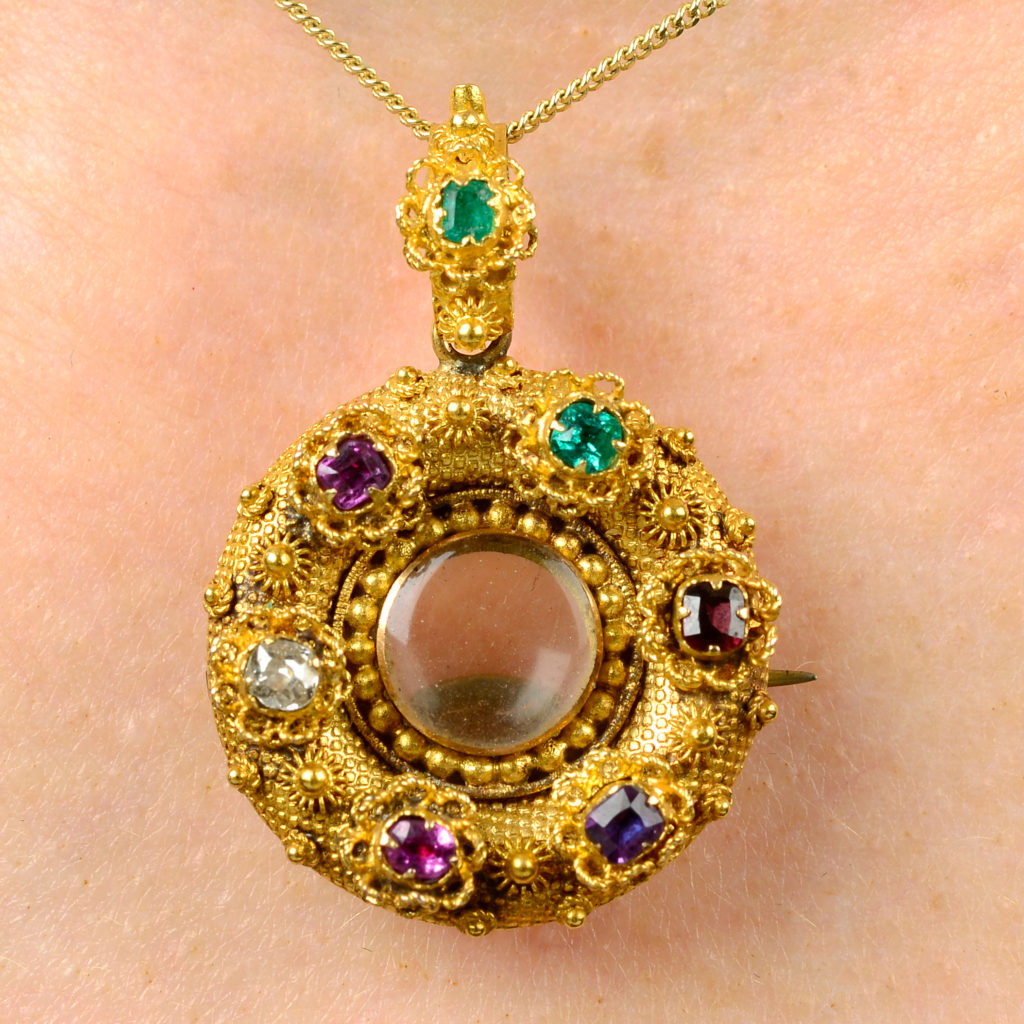By Georgina Izzard
Antique acrostic jewels are having a revival. Laden with secret messages – though decipherable when you know what you’re looking for – these jewels capture our attention as much now as they did when they were first gifted.
Intro on Acrostic Jewellery

Like an acrostic poem that spells a word or phrase with the first letter of each line, an acrostic jewel uses its gemstones to spell a word with the first letter of each stone’s name.
The Georgian acrostic jewels in our recent Fine Jewellery auction on 31 March 2022 all spelt ‘regard’, a favoured sentiment in Georgian Britain, using the stones ruby, emerald, garnet, amethyst, ruby and diamond. These stones can be arranged in lines, circles or as the petals of a flower on bracelets, pendants, brooches and rings, so spotting and reading an acrostic jewel takes a special eye.
These jewels’ allure rests in their secret messages. In the late eighteenth and early nineteenth centuries, courting was a complex game for young couples; parents, siblings and designated chaperons accompanied hopeful couples as they promenaded through parks and attended balls. Passing messages in gem-set gifts therefore allowed a rare, private intimacy.
The acrostic messages could also be compounded by adding other meaningful motifs from the language of flowers or memorial jewellery. Using gemstones to depict the five petals of a pansy – often with a diamond set in the centre to spell ‘regard’ – gave the further message of ‘remember me’. Forget-me-not flowers were another obvious choice to arrange in gold or turquoise around the stones of the acrostic message. Other jewels feature a locket or glass compartment to hold a woven lock hair from a loved one, a design element commonly found in memorial jewellery.
History of Acrostic Jewellery
Acrostic jewels are believed to have originated in France and their phrases like ‘j’adore’ (I love/adore) and ‘souvenir’ (remember/memory) inspired British goldsmiths to adapt the design for favoured English terms. In the newly formed Britain, the reigns of the four Hanoverian King Georges (r.1714-1830) aligned with massive developments in the manufacturing and production industries. This industrial revolution was underpinned by the work of thousands in the new factories but concentrated wealth in the hands of industrialists and landowners. Though long wars affected the international supply of precious metals and gemstones, these wealthy patrons of the arts were still determined to use jewellery to display their social standing.
When Queen Victoria ascended to the throne in 1837, she became the lead taste-maker of jewellery fashions and had access to gemstones from across the growing empire. Her husband, Prince Albert, shared her love for sentimental jewellery and gifted Victoria many jewels laden with secret messages. With the royal seal of approval, the popularity of the acrostic jewel lived on through Victoria’s long reign.
Finding antique acrostic jewels today becomes a treasure hunt for fans of sentimental jewellery. If a jewel is set with gemstones of many different colours, rather than a strict colour palette, the jewel may be hiding an acrostic meaning in addition to its overall design. Many gemstones have been known by more than one name, so trying name variations can help with decoding an acrostic jewel; ‘love’, for instance, could be spelt with lapis lazuli, opal, vermeil (an old name for garnet) and emerald. It’s easy to understand then how decoding an acrostic jewel and understanding its romantic nature is such a thrill.
Valuations
Our valuations are free, with no obligation to sell with us. Our experts will value your item with an estimate, so you can find out what it could achieve at auction.
The process is simple, so you can get a valuation now:
Fill in a form online. In addition, you can book an appointment to visit our offices in Birmingham and London. Moreover, you can book a virtual valuation appointment.

